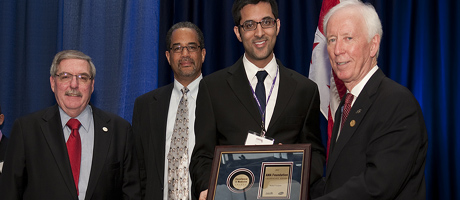By Anna Miller
Since the first day of medical school, Rahul Vanjani has gone above and beyond to promote health care for those who need it most.
Last year, as co-director of GW's student-run Health, Education, Active Living (HEALing) Clinic, he helped to establish a second clinic site in Anacostia, where underserved patients can receive primary care.
This year he's been focusing his efforts on managing Seeding Communities – a nonprofit organization that seeks to improve maternal and child health in developing countries around the world.
His passion for caring for underserved communities was recognized by the American Medical Association Foundation when they awarded Mr. Vanjani a 2011 Excellence in Medicine Leadership Award last month. The award, which is given to only 24 medical students nationwide, recognizes strong, non-clinical leadership skills in advocacy, community service and education. Mr. Vanjani, B.A. ’07, is the first GW medical student to receive the award since 2003.
“Rahul’s commitment to the community and leadership of service efforts are unparalleled,” says Scott Schroth, senior associate dean of academic affairs at GW’s School of Medicine and Health Sciences. “He exemplifies the sort of creativity and dedication that we look for in medical students at GW, and we are extraordinarily proud of him as a winner of the AMA Foundation’s 2011 Leadership Award.”
Mr. Vanjani, who is pursuing a career in primary care and health care development, said running the clinic was a great experience because it taught him to be very systematic in his approach to problems.
“I tried to set the standard that no matter how big or small the issue at hand, we would always have a healthy debate,” says Mr. Vanjani, who after graduating with a bachelor’s degree from GW in 2007 received a Master of Science degree in integrated immunology from the University of Oxford. “I think it’s important to foster communication and to build consensus to come up with the best solution, and we came up with a lot of great solutions that way.”
Now that he and his co-director, Marissa Watts, have abdicated most of their HEALing clinic responsibilities — a move Mr. Vanjani admits was “sad but good, because we were exhausted”— Mr. Vanjani is refocusing his service efforts on his own nonprofit organization, Seeding Communities, which he founded as a college freshman.
“Seeding Communities is not about planting trees,” he says. “It’s about promoting maternal and child health in rural areas abroad.”
In 2006, Seeding Communities bought and donated an ambulance to an HIV/AIDS clinic in New Delhi, India, where patients in need of critical care had previously been transported via auto-rickshaw. In 2008, the organization established an art therapy program at a free health clinic in Kampala, Uganda. Now, Mr. Vanjani and his team — which is composed of medical students, residents and attending physicians as well as several lawyers and consultants — are in the midst of their biggest project to date: establishing a comprehensive maternal and child health care program in the Krishnagiri District of Tamil Nadu, India.
“As our nation continues to struggle with issues of access, disease prevention and disparities in care, encouraging the next generation of leaders is critical,” says Barney R. Maynard, president of the American Medical Association Foundation. “We need individuals like [Mr. Vanjani] who are taking the initiative to tackle health care’s most difficult challenges.”
Meanwhile, Mr. Vanjani is living the frenzied life of a typical third-year medical student. He is looking forward to publishing a study about medication adherence among HIV-positive patients, a project he designed with fellow medical student Caitlin Pedati under the direction of Gary Simon, the Walter G. Ross Professor of Clinical Research.
“This process was one of my favorite endeavors because it’s a good example of how students at GW come together to effect change in the community,” he says. “At the end of the day, the best part about GW is the people – my friends in my medical school class. I think I learn more from them than from any other source.”


